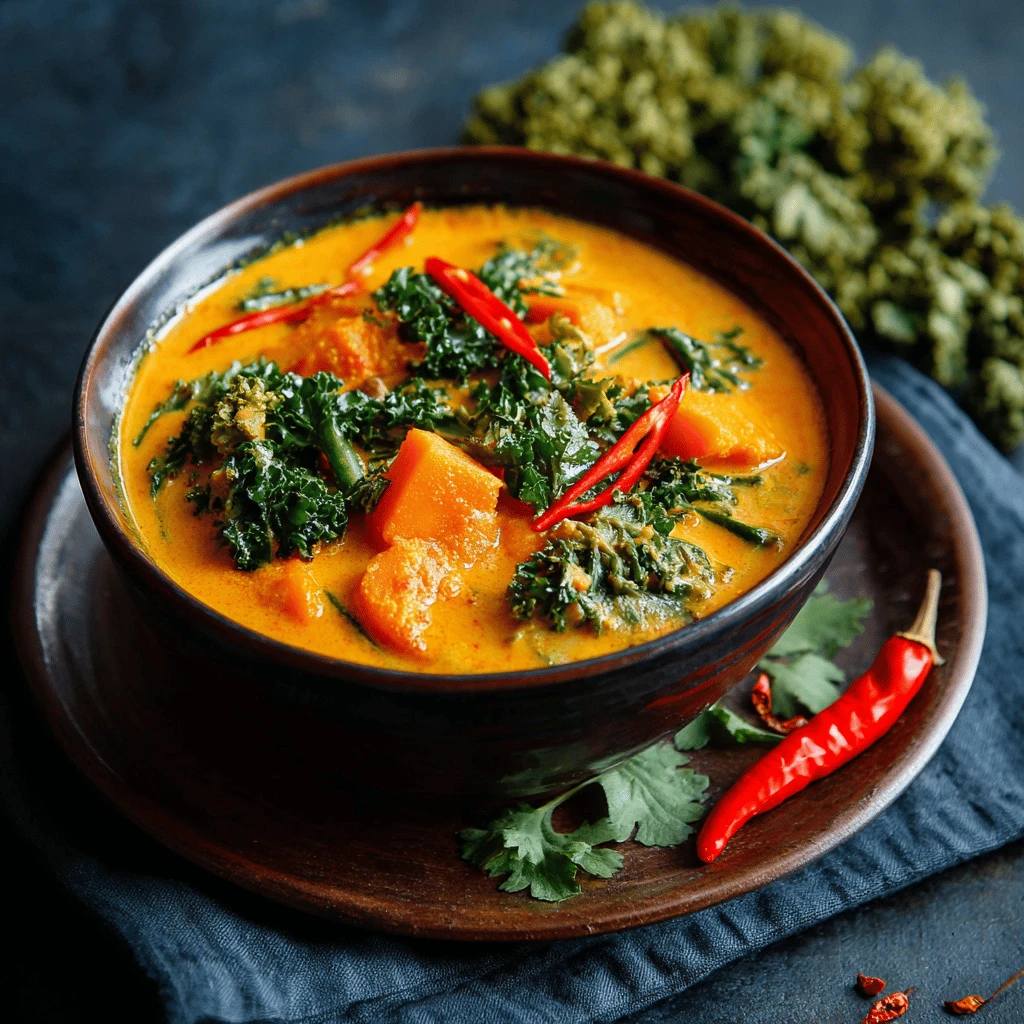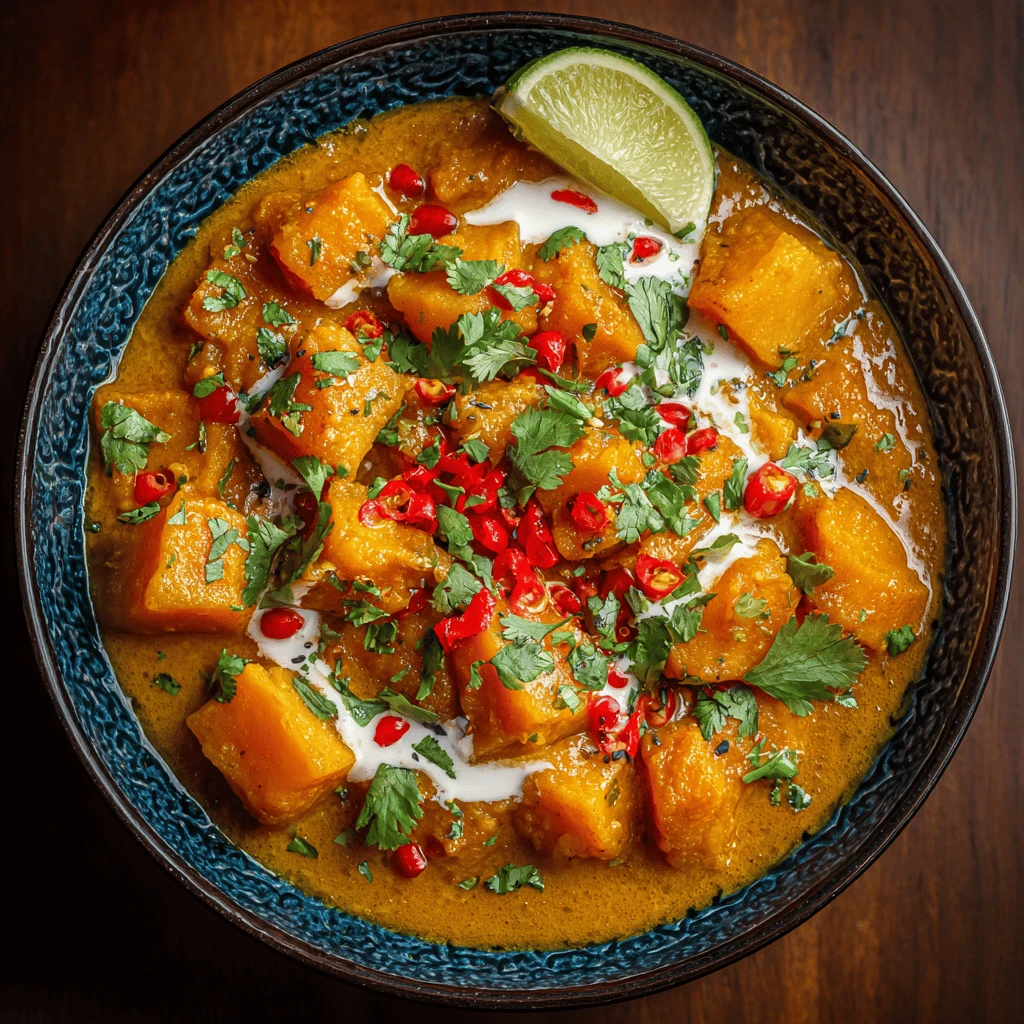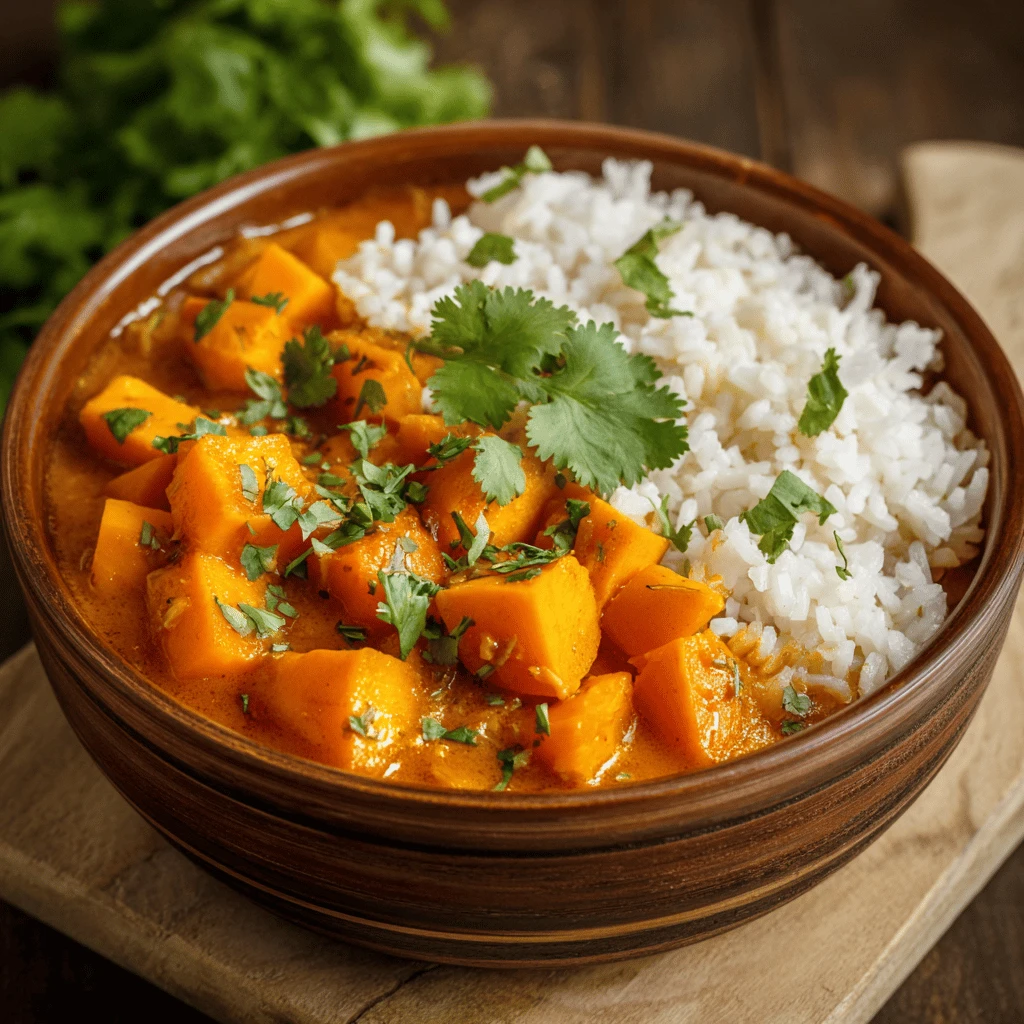Quick Healthy Pumpkin Curry: A Flavorful & Nutritious Delight
Introduction: Why Pumpkin Curry is Your New Go-To
Pumpkin curry is a vibrant and versatile dish that seamlessly blends the comforting sweetness of pumpkin with the aromatic warmth of curry spices. Not only is it incredibly delicious, but it’s also packed with nutrients, making it a fantastic healthy meal option. This guide will walk you through creating a quick and healthy pumpkin curry that you can enjoy any night of the week. Whether you’re a seasoned chef or a kitchen novice, this recipe is easily adaptable to your preferences and dietary needs.
Section 1: Understanding the Nutritional Power of Pumpkin
Pumpkin is more than just a festive decoration; it’s a nutritional powerhouse. Rich in vitamins, minerals, and antioxidants, pumpkin offers a wide range of health benefits.
Vitamin A for Vision and Immunity
Pumpkin is exceptionally high in Vitamin A, which is crucial for maintaining healthy vision, supporting immune function, and promoting healthy skin. Just one cup of cooked pumpkin provides well over 200% of the recommended daily intake of Vitamin A.
Fiber for Digestive Health
The high fiber content of pumpkin aids in digestion, promoting regularity and preventing constipation. Fiber also helps you feel full for longer, which can be beneficial for weight management.
Antioxidants for Overall Well-being
Pumpkin is loaded with antioxidants like beta-carotene, which helps protect your cells from damage caused by free radicals. These antioxidants are linked to a reduced risk of chronic diseases such as heart problems and certain types of cancer.
Potassium for Heart Health
Pumpkin is a good source of potassium, an essential mineral that helps regulate blood pressure and supports healthy heart function.
Low in Calories, High in Satisfaction
Despite its sweet taste, pumpkin is relatively low in calories, making it a guilt-free addition to your diet. Its creamy texture and rich flavor provide a satisfying meal experience without derailing your health goals.
Section 2: Crafting the Perfect Pumpkin Curry: Ingredients & Preparation
The beauty of pumpkin curry lies in its adaptability. Feel free to adjust the ingredients and spice levels to suit your taste. Here’s a guide to getting started.
Essential Ingredients
- Pumpkin: Fresh pumpkin is best, but canned pumpkin puree works well for convenience. Choose 1-2 pounds of fresh pumpkin or a 15-ounce can of puree. If using fresh, consider sugar pumpkins or pie pumpkins for the best flavor.
- Coconut Milk: Full-fat coconut milk adds richness and creaminess to the curry. You can use light coconut milk for a lower-fat option, but the flavor and texture will be slightly different.
- Curry Paste: Red, yellow, or green curry paste all work well in this recipe. Red curry paste provides a spicier flavor, while yellow and green are milder. Start with 1-2 tablespoons, adjusting to your preferred spice level.
- Aromatics: Onion, garlic, and ginger form the base of the curry flavor. Use one medium onion, 2-3 cloves of garlic, and a 1-inch piece of ginger, all finely chopped.
- Vegetables: Add your favorite vegetables to the curry. Bell peppers, spinach, broccoli, cauliflower, peas, and green beans all work well.
- Protein (Optional): Tofu, chickpeas, chicken, or shrimp can be added for extra protein. If using tofu, press it to remove excess water before adding it to the curry.
- Broth: Vegetable broth or chicken broth adds moisture and depth of flavor to the curry.
- Lime Juice: A squeeze of lime juice at the end brightens the flavors and adds a touch of acidity.
- Spices: In addition to the curry paste, you can add other spices like turmeric, cumin, coriander, and chili flakes to enhance the flavor.
- Oil: Coconut oil or olive oil for sautéing the aromatics.
- Sweetener (Optional): A touch of maple syrup or brown sugar can balance the flavors, especially if your curry paste is particularly spicy.
Step-by-Step Preparation
1. Prepare the Pumpkin: If using fresh pumpkin, peel, deseed, and cube it into 1-inch pieces.
2. Sauté the Aromatics: Heat the oil in a large pot or Dutch oven over medium heat. Add the chopped onion and cook until softened, about 5 minutes. Add the garlic and ginger and cook for another minute until fragrant.
3. Add Curry Paste: Stir in the curry paste and cook for 1-2 minutes, allowing the flavors to bloom.
4. Incorporate Vegetables and Protein: Add the pumpkin and any other vegetables you’re using to the pot. If using tofu, chickpeas, chicken, or shrimp, add them now as well.
5. Simmer in Coconut Milk and Broth: Pour in the coconut milk and broth, and bring to a simmer. Reduce the heat and cook until the pumpkin and vegetables are tender, about 15-20 minutes.
6. Season and Serve: Stir in the lime juice and any additional spices you’re using. Taste and adjust the seasoning as needed. Serve the curry over rice or quinoa, garnished with fresh cilantro or green onions.
Section 3: Variations and Adaptations to Suit Your Taste
Pumpkin curry is a highly customizable dish. Here are some ideas for variations and adaptations to suit your dietary needs and preferences.
Vegan Pumpkin Curry
To make this recipe vegan, ensure that your curry paste is vegan-friendly (some may contain fish sauce). Use tofu or chickpeas as your protein source and vegetable broth as the base. Consider adding a handful of spinach or kale towards the end of cooking for an extra boost of nutrients.
Gluten-Free Pumpkin Curry
Most curry pastes are naturally gluten-free, but it’s always a good idea to check the label to be sure. Serve the curry over rice or quinoa, which are both gluten-free grains.
Spicier Pumpkin Curry
If you like your curry with a kick, add a pinch of chili flakes or a chopped chili pepper to the pot along with the curry paste. You can also use a spicier curry paste, such as red or Panang curry paste.
Sweeter Pumpkin Curry
If you prefer a sweeter curry, add a drizzle of maple syrup or brown sugar to the pot along with the coconut milk and broth. You can also add a pinch of cinnamon or nutmeg for a warm, comforting flavor.
Using Different Vegetables
Feel free to experiment with different vegetables in your pumpkin curry. Sweet potatoes, butternut squash, eggplant, and mushrooms all work well. You can also add leafy greens like spinach, kale, or bok choy for extra nutrients.
Adding Lentils
Red lentils or green lentils can be a great addition to pumpkin curry, adding protein and thickening the sauce. Add about 1/2 cup of lentils to the pot along with the coconut milk and broth, and cook until the lentils are tender, about 20-25 minutes.
Section 4: Tips for Perfecting Your Pumpkin Curry
Here are a few tips and tricks to help you make the best pumpkin curry possible.
Choosing the Right Pumpkin
When using fresh pumpkin, choose sugar pumpkins or pie pumpkins for the best flavor and texture. These pumpkins are smaller and sweeter than carving pumpkins.
Roasting the Pumpkin
Roasting the pumpkin before adding it to the curry can enhance its flavor and sweetness. Simply toss the pumpkin cubes with olive oil, salt, and pepper, and roast at 400°F (200°C) for 20-25 minutes, or until tender.
Blooming the Spices
Cooking the curry paste and other spices in oil before adding the other ingredients helps to bloom the flavors and release their aromas.
Simmering for Flavor
Allowing the curry to simmer for at least 15-20 minutes helps the flavors meld together and create a richer, more complex taste.
Balancing the Flavors
The key to a great curry is balancing the sweet, spicy, salty, and sour flavors. Taste the curry as it cooks and adjust the seasoning as needed. Add a squeeze of lime juice for brightness, a pinch of salt for saltiness, and a touch of sweetener for sweetness.
Storage and Reheating
Pumpkin curry can be stored in the refrigerator for up to 3-4 days. Reheat it gently on the stovetop or in the microwave until heated through. You may need to add a splash of water or broth to thin the curry if it has thickened in the refrigerator.
Section 5: Serving Suggestions and Pairings
Pumpkin curry is a versatile dish that can be served in a variety of ways. Here are some serving suggestions and pairings to inspire you.
Serving Suggestions
- Over Rice or Quinoa: Serve the curry over steamed rice or quinoa for a hearty and satisfying meal.
- With Naan Bread: Serve the curry with warm naan bread for dipping and scooping.
- As a Soup: Thin the curry with extra broth and serve it as a soup, garnished with fresh cilantro or green onions.
- In Lettuce Wraps: Spoon the curry into lettuce wraps for a light and refreshing meal.
- As a Side Dish: Serve the curry as a side dish alongside grilled chicken, fish, or tofu.
Pairing Suggestions
- Raita: Serve the curry with raita, a yogurt-based condiment, to cool down the spice.
- Mango Chutney: Pair the curry with mango chutney for a sweet and tangy contrast.
- Pickled Vegetables: Serve the curry with pickled vegetables like kimchi or sauerkraut for a tangy and flavorful addition.
- Green Salad: Pair the curry with a simple green salad with a light vinaigrette to balance the richness of the dish.
- Wine: A crisp white wine like Sauvignon Blanc or Pinot Grigio pairs well with pumpkin curry.
Frequently Asked Questions (FAQ)
Can I use canned pumpkin instead of fresh pumpkin?
Yes, canned pumpkin puree is a convenient alternative to fresh pumpkin. Use a 15-ounce can of pumpkin puree in place of 1-2 pounds of fresh pumpkin.
How do I make pumpkin curry less spicy?
Start with a smaller amount of curry paste and avoid using red curry paste, which is spicier than yellow or green curry paste. You can also add a dollop of yogurt or sour cream to cool down the spice.
Can I freeze pumpkin curry?
Yes, pumpkin curry can be frozen for up to 2-3 months. Allow the curry to cool completely before transferring it to an airtight container. Thaw in the refrigerator overnight before reheating.
What other vegetables can I add to pumpkin curry?
Many vegetables work well in pumpkin curry, including sweet potatoes, butternut squash, eggplant, bell peppers, spinach, kale, broccoli, cauliflower, peas, and green beans.
How can I thicken my pumpkin curry?
If your pumpkin curry is too thin, you can thicken it by simmering it for a longer period of time to allow the liquid to evaporate. You can also add a tablespoon of cornstarch or arrowroot powder mixed with water to the curry and simmer until thickened. Another option is to add a can of drained and rinsed chickpeas, which will help to thicken the sauce as they break down.




